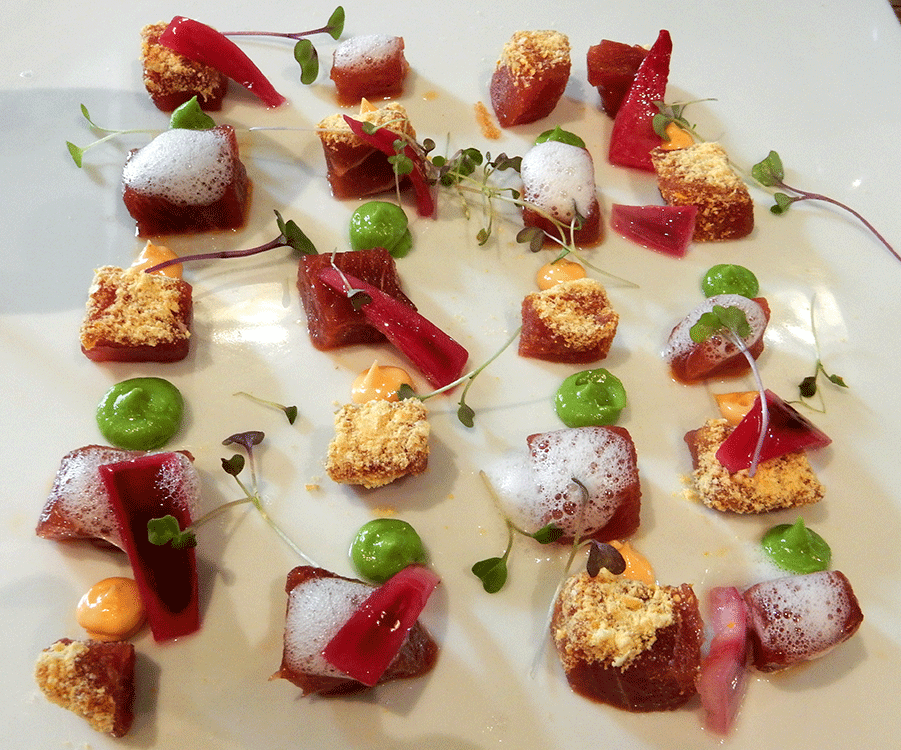Seems too long since this blog made a food stop.
Fresh red tuna was running while we were in Spain this spring and summer, and the above photo represents an upscale presentation of it from the kitchen of chef Gonazlo Jurado of Tradevo Centro. The name represents a fusion of the words tradition and evolution. An avocado roll, or canelon, filled with shrimp is particularly luscious.
Like Tradevo, ConTendor Slow Food Restaurant is a little more upscale than we tend to frequent, but neither results in particularly high tabs at lunchtime. The long and varied daily menu is written on a large chalk board, and the server reads through the entire thing with you to see if you have any questions. It can be parked on your table briefly for consideration, but on a two-top it is awkward to read and we quickly found ourselves forgetting what some of the dishes were. Everything is presented artfully, such as an unusual deconstructed dessert of eucalyptus ice cream with creamy meringue and basil hazelnut paste on the side.
The winner for our favorite people-watching patio is Quilombo. The casual spot is on an intimate plaza on a mainly pedestrian narrow street frequented by locals. The mussels and salmon burgers are good, but it was the patio that really drew us back.
While one Arte y Sabor Tapas is located on Plaza Hercules, there is an overflow one about half a block away that attracts more locals. The prosciutto-wrapped asparagus and the falafel are welcome changes. Artefacto Grill & Beers is just off the plaza as well, and, as a result, snagging a table at lunch is much easier. Love their cheesy rice-filled zucchini and croquetas filled with spinach and pine nuts. Burgers, from veggie to retinto beer, are their specialties.
We did not realize when we stumbled across Vida Loca that it had only been open a week. The neighborhood evidently was keenly aware, so it was packed. The traditional garbanzo stew and boquerones are spot on, and the plate piled high with fresh vegetables and slices of jamon is uncommonly varied. Tucked away on a side street and seemingly undiscovered by many tourists, tables in Estraperlo are wedged between shelves holding fresh vegetables and other “ecological market” items for sale. We shared a lunch of artichokes with jamon and a stir-fry with shrimp.
We tried more than one Morroccan/Arab restaurant but were shocked to find our most successful meal in that vein right smack in the middle of one of the areas most congested by tourists – a Halal restaurant, Al Wadi. The chilled squash with a pomegranate, honey and lemon sauce is a pleasant starter, and lamb arrives atop the most flavorful savory rice ever entering my mouth. And then, right under the landmark visitor magnet Las Setas, was Malavida Tapas. I almost left it off the list, but the photos rescued it at the last minute. We went on a rare rainy day, so it was empty instead of overrun. The vegetables, the seedy avocado salad and the beef panes are all much better than one would expect to find in the location.
The final stop offered for your meal consideration in Sevilla almost reminded me of the old Europe on $5 a day (pretty nigh on impossible even in the olden days) guidebooks; it was that much a bargain. A simple neighborhood hole-in-the-wall, El Enano Verde offers ridiculously low-priced freshly prepared vegetarian fare. Both our wok-style vegetables and black rice with snow peas resulted in clean plates. I am including this because it is an ideal conscious-clearing spot to balance your budget and your calories after indulging in too many splurge meals.
But, you might ask, where is the pizza? Anyone who knows us is aware we don’t travel for long without pizza. We tried several in Seville but failed to find one we would recommend. But our Spanish options were so abundant we survived easily.









































































